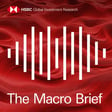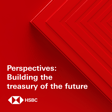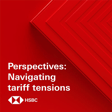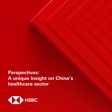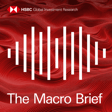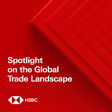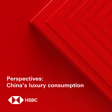Become a Creator today!Start creating today - Share your story with the world!
Start for free
00:00:00
00:00:01

The Macro Viewpoint - Higher rates headache, tracking China’s recovery, gold rush
James Pomeroy looks at how concerns over financial stability have affected the global economic outlook, Erin Xin provides an update on China’s recovery and James Steel examines whether the recent surge in the gold price can be sustained.
Disclaimer: https://www.research.hsbc.com/R/51/sjM6pqQ Stay connected and access free to view reports and videos from HSBC Global Research follow us on LinkedIn https://www.linkedin.com/feed/hashtag/hsbcresearch/ or click here: https://www.gbm.hsbc.com/insights/global-research.
Hosted on Acast. See acast.com/privacy for more information.
Transcript
Podcast Introduction
00:00:01
Speaker
Welcome to HSBC Global Viewpoint, the podcast series that brings together business leaders and industry experts to explore the latest global insights, trends, and opportunities.
00:00:13
Speaker
Make sure you're subscribed to stay up to date with new episodes.
00:00:16
Speaker
Thanks for listening, and now onto today's show.
00:00:23
Speaker
The following podcast was recorded for publication by HSBC Global Research.
00:00:27
Speaker
All the disclosures and disclaimers associated with it must be viewed on the link attached to your media player.
Financial Stability and China's Economic Recovery
00:00:40
Speaker
Hello, I'm Piers Butler in London.
00:00:42
Speaker
And I'm Aline Van Dyne in New York.
00:00:44
Speaker
Coming up on today's programme, we look at how concerns over financial stability have affected the global economic outlook.
00:00:51
Speaker
We check in on China to find out how the economic recovery is progressing.
00:00:56
Speaker
And we look at why the price of gold has been soaring close to record highs.
00:01:03
Speaker
As we enter the second quarter of the year, volatility has gone up a notch, with the failures of banks drawing the attention of markets towards financial stability issues.
00:01:11
Speaker
This week, James Pomeroy, global economist, has been poring over the latest data to find out where pressure is being felt most.
00:01:18
Speaker
He joins us now.
00:01:19
Speaker
James, welcome to the podcast.
00:01:20
Speaker
Thank you for having me.
00:01:22
Speaker
So after the banking storm, what's the data looking like?
00:01:25
Speaker
Surprisingly good.
00:01:26
Speaker
If you actually looked at the global data for March, if you looked at the survey data, so the PMIs, you looked at some consumer confidence data, you wouldn't have known anything had happened.
00:01:36
Speaker
We saw actually an improvement in quite a lot of these numbers, PMI numbers picking up on a global basis, not just in China, not just in Europe, but actually...
00:01:44
Speaker
almost across the board.
00:01:46
Speaker
And by and large, things look much, much better than you'd expect.
00:01:48
Speaker
It's as if the average person on the street or the average business hasn't felt any impact of this crisis, which is maybe a testament to the actions that authorities and put in place very, very quickly.
00:01:58
Speaker
And talking about some of the differences within the data, one of the features post-COVID lockdowns was that people have moved away from buying stuff to doing things, going on holiday and
Shifts in Spending Post-COVID
00:02:09
Speaker
services.
00:02:09
Speaker
Is that being reflected in the data?
00:02:11
Speaker
Yes.
00:02:12
Speaker
Very, very clearly.
00:02:13
Speaker
So if you look in the PMI numbers, for example, the global manufacturing PMI edged down in March.
00:02:19
Speaker
Part of that was China, but we saw this pretty much across the board.
00:02:22
Speaker
The manufacturing sector globally is struggling a little bit just because, as you say, people don't need to buy as much stuff.
00:02:28
Speaker
We bought loads of things during the pandemic and we're cutting back a little bit there as cost of living squeezes, hurting some people's maybe willingness or ability to buy certain items.
00:02:37
Speaker
But it's a service side of the economy that just remains rampant.
00:02:40
Speaker
And you can see this in the PMI numbers, you can see it in the consumer spending data, you can see it in the retail sales parts of the data where they include some services.
00:02:49
Speaker
You've generally got this big pickup in services demand, whereas it's good spending that's been much, much weaker.
00:02:54
Speaker
So if you look at retail sales volumes across the world, they've been really badly hit, particularly in Europe.
00:03:00
Speaker
And the standout is Sweden, where you've got retail sales volumes down more than 8% year on year.
00:03:05
Speaker
So a big squeeze.
00:03:07
Speaker
When household income is there, I'm feeding through into much
Inflation Trends and Central Bank Responses
00:03:10
Speaker
lower spending.
00:03:10
Speaker
And what about inflation?
00:03:11
Speaker
Are we starting to see some better news, though?
00:03:13
Speaker
I think we are.
00:03:15
Speaker
Yes, some of the headline figures you get are heavily distorted by energy prices or some of the sort of base effects that are still in these numbers.
00:03:22
Speaker
And yes, in the US, you've still got this big role that rental inflation is playing, particularly on core inflation, is heavily distorting.
00:03:29
Speaker
that data.
00:03:30
Speaker
But if you step back and you look at the input cost data, you look at supply chains, which continue to look much, much better.
00:03:35
Speaker
You look at input price indices from the PMIs, supply delivery time indices in the PMIs.
00:03:41
Speaker
These all look much, much better.
00:03:42
Speaker
Commodity prices keep falling.
00:03:44
Speaker
Food inflation is a great example of this, where food prices on wholesale markets have fallen for 12 months in a row.
00:03:50
Speaker
Now, this isn't hitting food inflation in the UK or in Europe yet, but it surely will later this year.
00:03:56
Speaker
So we're getting a lot of sense, at least, that all of these leading indicators for inflation are looking much, much better.
00:04:02
Speaker
And this should hopefully mean inflation continues to come down through this year.
00:04:06
Speaker
So the central banks are the ones who look at that data.
00:04:09
Speaker
How have they been responding to it?
00:04:11
Speaker
So it's incredibly difficult for them because I mentioned at the beginning that the average person or average business isn't really seeing much impact of this banking crisis or banking shock yet.
00:04:20
Speaker
But they could do further down the line and we could start to see a little bit of tightness in credit conditions.
00:04:25
Speaker
This could mean slower lending growth.
00:04:27
Speaker
This could feed through into the economy more broadly.
00:04:29
Speaker
And central banks appear to be quite concerned about those risks.
00:04:32
Speaker
And that's why they might be a little bit more reluctant to tighten policy as much as they might initially want to, given this still high inflation rates and this relatively resilient consumer spending story.
00:04:44
Speaker
So actually, we do think that the Federal Reserve, the ECB, will continue to raise rates for their next couple of meetings.
00:04:49
Speaker
but then they're going to be at their peaks.
00:04:51
Speaker
And other central banks, such as the Bank of Canada or the Bank of England, look like they're at their peak as well.
00:04:56
Speaker
So central banks, at least for now, are weighing up these two different sides of the equation.
00:05:01
Speaker
They're looking at what's happening with inflation and some of that activity data, but keeping in mind those financial stability risks.
00:05:06
Speaker
And it does look like interest rates have maybe got just a little bit more to go, but not much.
00:05:11
Speaker
James, thanks for joining us.
00:05:12
Speaker
Thank you.
China's Economic Recovery and Growth
00:05:17
Speaker
One of the dominant themes this year is China's reopening and its impact on the rest of the global economy.
00:05:23
Speaker
So let's head to Asia to find out how the recovery is progressing.
00:05:26
Speaker
Erin Zinn is our Greater China Economist.
00:05:29
Speaker
She spoke to Graham Mackay earlier.
00:05:31
Speaker
Erin, thank you very much for joining us and bringing us up to date on the recovery in mainland China.
00:05:36
Speaker
Thank you very much for having me.
00:05:38
Speaker
So we'll get to the broad recovery in just a moment.
00:05:40
Speaker
But first of all, there was some trade data that came out today, Thursday, that you wanted to tell us about.
00:05:45
Speaker
Yeah, so the trade data was quite a surprise.
00:05:49
Speaker
Exports had shot up to almost 15% year on year.
00:05:52
Speaker
This is the first increase since about October last year.
00:05:57
Speaker
And it's been a bit of a surprise because we had expected that global demand would continue to be fairly weak.
00:06:06
Speaker
But our interpretation of this is that in the first two months of this year, because of the disruptions from COVID-19 with the peak outbreak, as well as the Chinese New Year holidays, that has led to some delays in the operations and the production of shipments, and that was likely pushed into March.
00:06:27
Speaker
So I think that that's probably why we see such a strong rebound in March.
00:06:31
Speaker
And I think looking ahead, this bounce back, you know, there's still some uncertainty on the global backdrop.
00:06:37
Speaker
So we think that this bounce back might be short lived.
00:06:42
Speaker
OK, so basically we shouldn't read too much into this export bounce in terms of how the rest of the global economy might be doing.
00:06:49
Speaker
Yeah, and I think that when we look at the breakdown of the data, it's actually pretty interesting because you do have some points of strength.
00:06:56
Speaker
ASEAN's very strong.
00:06:59
Speaker
But some areas like exports to the U.S., that's continued to be in contraction.
00:07:04
Speaker
And when we look at the product breakdown, things like exports of transportation-related goods like autos, airline parts, as well as services-related goods,
00:07:15
Speaker
suitcases, clothing, those have been very strong.
00:07:18
Speaker
But this electronics demand slump, that's been ongoing.
00:07:22
Speaker
And I think that that's pretty reflective of that rotation towards more service-oriented consumption in the post-recovery period.
00:07:32
Speaker
OK, and we've said since the beginning that this is going to be a consumption-led recovery for mainland China.
00:07:39
Speaker
That's certainly what we saw in the early days when the COVID restrictions were first lifted.
00:07:44
Speaker
Is that still the case?
00:07:45
Speaker
Is the consumer still driving that rebound?
00:07:47
Speaker
Yeah, so a lot of the high frequency data has been very optimistic, especially in terms of the services consumption recovery.
00:07:57
Speaker
So in mainland China, things like domestic tourism, box office movie sales, as well as traffic congestion data, those have recovered to pre-pandemic levels.
00:08:09
Speaker
So that's pretty strong.
00:08:10
Speaker
But I think that when we're looking at some of the leading indicators, like the purchasing managers index, that can shed some light on the fact that it's kind of a two track recovery.
00:08:21
Speaker
So consumption is likely to be very strong.
00:08:25
Speaker
There's some pent up demand here.
00:08:26
Speaker
There's excess savings that's supporting it.
00:08:29
Speaker
But things like manufacturing, it started to show a little slowdown in the momentum.
00:08:35
Speaker
So I think that that can be reflective of ongoing weakness in the global demand picture.
00:08:41
Speaker
And
China's Fiscal and Monetary Support
00:08:42
Speaker
then the other side is that China still faces labor market pressure.
00:08:47
Speaker
So that's another point of stress.
00:08:49
Speaker
So I think that even though the recovery is well underway, particularly in services consumption, there are points of stress for the economy.
00:08:59
Speaker
And does that imply a greater need for support on the monetary or fiscal side?
00:09:04
Speaker
Yeah, that's exactly right.
00:09:05
Speaker
I think that we're going to continue to see a lot of fiscal support, things like tax cuts and fee reductions, as well as ongoing special local government bond issuance.
00:09:16
Speaker
On the monetary policy side, we're expecting they're going to remain accommodative.
00:09:20
Speaker
Inflationary pressures are still very muted.
00:09:24
Speaker
in mainland China, so that's going to allow the PBOC the space to continue easing.
00:09:30
Speaker
And we think this is really going to come through more quantity-based tools like RRR cuts.
00:09:35
Speaker
All right.
00:09:35
Speaker
And finally, we do have a significant economic indicator coming out of mainland China.
00:09:41
Speaker
That's Q1 GDP out next week.
00:09:44
Speaker
What are your expectations there?
00:09:46
Speaker
So we're expecting that sequentially we'll have an increase of about 1% Q on Q. This is notable because last quarter we saw basically flat growth on a sequential basis given the drag from COVID.
00:10:02
Speaker
But as I mentioned, some of the high frequency data, some of the January, February data, that's been very supportive that the recovery is ongoing.
00:10:11
Speaker
And this will translate to about a 2.2% year on year increase.
00:10:15
Speaker
Very good.
00:10:15
Speaker
Erin, thank you very much indeed for the update.
00:10:17
Speaker
Thank you for having me.
Gold Prices and Financial Instability
00:10:22
Speaker
Now, earlier we heard from James about growing concerns over the stability of the financial system.
00:10:29
Speaker
One beneficiary of this uncertainty has been gold, which surged above $2,000 an ounce as investors sought safe haven assets.
00:10:39
Speaker
So can this high price be sustained or is a gold rush over?
00:10:44
Speaker
James Steele, Chief Precious Metals Analyst, joins me to discuss.
00:10:49
Speaker
Jim, thanks for joining us.
00:10:51
Speaker
Let's start with some context.
00:10:53
Speaker
Just talk us through what's been driving the gold market, especially in the last year.
00:10:58
Speaker
Well, the market's been very interesting in the past 12 to 15 months and risk
00:11:04
Speaker
Whether the risk is increasing or decreasing has been what's been driving gold.
00:11:09
Speaker
The market soared above $2,000 per ounce, getting close to all-time highs in the immediate aftermath of the Ukraine invasion last year, and then subsequently sank as risk came out of the market and interest rates began to rise.
00:11:24
Speaker
Now, this year, we've seen risk of a different sort.
00:11:27
Speaker
Bank stresses has superseded geopolitical risk and taken the market significantly higher on safe haven buying, which has sustained it so far.
00:11:38
Speaker
So, Jim, what's the outlook?
00:11:39
Speaker
I mean, will this gold rush last?
00:11:43
Speaker
Well, if I can compare it to last year when we ran up and then sold off as risk declined,
00:11:50
Speaker
If in fact bank stresses are going to begin to relieve the market and the financial system is steadier, then that's going to undercut the safe haven bid for gold, which has taken the market up so sharply.
00:12:03
Speaker
Because one of the other things that happens when the market goes up like this is that price sensitive emerging market physical demand, i.e.
00:12:10
Speaker
jewelry, coins and bars, recedes, leaving the market overextended on short term investment, if you like.
00:12:17
Speaker
Just in terms of this demand side, there has been record buying from central banks.
00:12:24
Speaker
Just explain that, and will that last?
00:12:27
Speaker
Well, we saw a very significant buying last year.
00:12:30
Speaker
You're absolutely correct.
00:12:31
Speaker
over 1,100 tons, we believe, was bought, which is almost double the previous record.
00:12:37
Speaker
And that's based off of geopolitical risks again, but also portfolio diversification, as there's some movement out of the dollar and other currencies, which the central banks have found attractive to park some of that money into gold.
00:12:54
Speaker
Now, we may not be able to get anywhere near the level of buying this year because foreign exchange levels may be down a little bit and also simply the very high price above $2,000.
00:13:06
Speaker
But we're still going to see fairly strong buying in historical terms, we believe, but not as robust as last year.
00:13:13
Speaker
Jim, thanks so much for the update.
00:13:15
Speaker
Thank you.
00:13:18
Speaker
So that's it for another week.
00:13:20
Speaker
Thanks to our guests, James Pomeroy, Erin Zinn and James Thiel.
00:13:24
Speaker
From all of us here, thanks for listening.
00:13:26
Speaker
We'll be back again next week.
00:13:47
Speaker
Thank you for joining us at HSBC Global Viewpoint.
00:13:51
Speaker
We hope you enjoyed the discussion.
00:13:53
Speaker
Make sure you're subscribed to stay up to date with new episodes.
